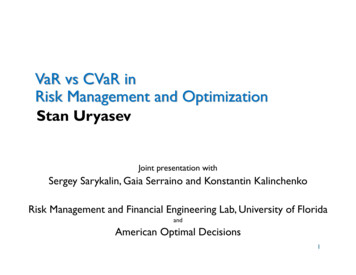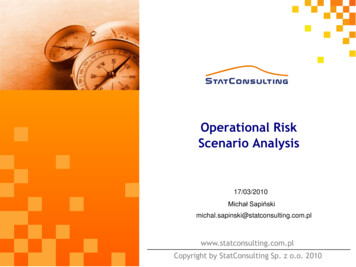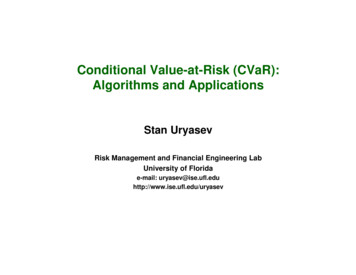
Transcription
VaR vs CVaR inRisk Management and OptimizationStan UryasevJoint presentation withSergey Sarykalin, Gaia Serraino and Konstantin KalinchenkoRisk Management and Financial Engineering Lab, University of FloridaandAmerican Optimal Decisions1
Agenda Compare Value-at-Risk (VaR) and Conditional Value-at-Risk (CVaR) definitions of VaR and CVaR basic properties of VaR and CVaR axiomatic definition of Risk and Deviation Measures reasons affecting the choice between VaR and CVaR risk management/optimization case studies conducted withPortfolio Safeguard package by AORDA.com2
Risk Management Risk Management is a procedure for shaping a loss distributionValue-at-Risk (VaR) and Conditional Value-at-Risk (CVaR) arepopular function for measuring riskThe choice between VaR and CVaR is affected by:differences in mathematical properties,stability of statistical estimation,simplicity of optimization procedures,acceptance by regulators Conclusions from these properties are contradictive 3
Risk Management Key observations: CVaR has superior mathematical properties versus VaR Risk management with CVaR functions can be done very efficiently VaR does not control scenarios exceeding VaR CVaR accounts for losses exceeding VaR Deviation and Risk are different risk management concepts CVaR Deviation is a strong competitor to the Standard Deviation4
VaR and CVaR Representation5
VaR, CVaR, CVaR and CVaR-RiskCVaR CVaRCVaRVaRx6
Value-at-RiskX a loss random variableVaRα ( X ) min{z FX ( z ) α } for α ]0,1[VaRα (X ) is non convex and discontinuous function of theconfidence level α for discrete distributionsVaRα (X ) is non-sub-additivedifficult to control/optimize for non-normal distributions:VaR has many extremums for discrete distributions7
Conditional Value-at-Risk Rockafellar and Uryasev, “Optimization of Conditional Value-at-Risk”,Journal of Risk, 2000 introduced the term Conditional Value-atRiskFor α ]0,1[ CVaRα ( X ) αzdF X ( z) wherewhen z VaRα ( X ) 0 αFX ( z ) FX ( z ) αwhen z VaRα ( X ) 1 α8
Conditional Value-at-RiskCVaR (Upper CVaR): expected value of X strictly exceeding VaR(also called Mean Excess Loss and Expected Shortfall) CVaRα ( X ) E[ X X VaRα ( X )] CVaR-(Lower CVaR): expected value of X weakly exceeding VaR(also called Tail VaR)CVaRα ( X ) E[ X X VaRα ( X )]Property: C V a Rα ( X ) is weighted average of C V a R α ( X ) and V a R α ( X ) λα ( X ) VaRα ( X ) (1 λα ( X )) CVaRα ( X ) if FX (VaRα ( X )) 1CVaRα ( X ) if FX (VaRα ( X )) 1 VaRα ( X )λα ( X ) FX (VaRα ( X )) α1 αzero for continuous distributions!!!9
Conditional Value-at-Risk Definition on previous page is a major innovation CVaRα ( X ) and VaRα ( X ) for general loss distributions arediscontinuous functions CVaR is continuous with respect to α CVaR is convex in X VaR, CVaR- ,CVaR may be non-convex VaR CVaR- CVaR CVaR 10
VaR, CVaR, CVaR and CVaR-RiskCVaR CVaRCVaRVaRx11
CVaR: Discrete Distributions α does not “split” atoms:VaR CVaR- CVaR CVaR ,λ (Ψ- α)/(1- α) 0Six scenarios,p1 p 2 L p 6 16 , α CVaR C VaR 12f5 12f1Loss f6CVaR 12
CVaR: Discrete Distributions α “splits” the atom:VaR CVaR- CVaR CVaR ,λ (Ψ- α)/(1- α) 0Six scenarios,p1 p 2 L p 6 16 , α CVaR 15 VaR 54 CVaR 15f4 f1f5 aRCVaR--1216f6f5 12 f6 CVaR 13
CVaR: Discrete Distributions α “splits” the last atom:VaR CVaR- CVaR ,CVaR is not defined, λ (Ψ - α)/(1- α) 014
CVaR: Equivalent Definitions Pflug defines CVaR via an optimization problem, as in Rockafellarand Uryasev (2000) Acerbi showed that CVaR is equivalent to Expected Shortfalldefined byPflug, G.C., “Some Remarks on the Value-at-Risk and on the Conditional Value-at-Risk”, ProbabilisticConstrained Optimization: Methodology and Applications, (Uryasev ed), Kluwer, 2000Acerbi, C., “Spectral Measures of Risk: a coherent representation of subjective risk aversion”, JBF, 200215
RISK MANAGEMENT: INSURANCEPaymentPaymentDeductiblePremiumAccident lostPDFAccident lostPDF DeductiblePaymentPremiumPayment
TWO CONCEPTS OF RISK Risk as a possible lossMinimum amount of cash to be added to make a portfolio (orproject) sufficiently safeExample 1. MaxLoss- Three equally probable outcomes, { -4, 2, 5 };MaxLoss -4; Risk 4- Three equally probable outcomes, { 0, 6, 9 };MaxLoss 0; Risk 0Risk as an uncertainty in outcomesSome measure of deviation in outcomesExample 2. Standard Deviation- Three equally probable outcomes, { 0, 6, 9 }; StandardDeviation 0
Risk Measures: axiomatic definition Afunctionalextended sense if:R1:R2:R3:R4:is a coherent risk measure in thefor all constant Cfor λ ]0,1[(convexity)when X X ' (monotonicity)whenwith(closedness) Afunctionalis a coherent risk measure in the basicsense if it satisfies axioms R1, R2, R3, R4 and R5:R5:for λ 0 (positive homogeneity)18
Risk Measures: axiomatic definition A functionalis an averse risk measure in theextended sense if it satisfies axioms R1, R2, R4 and R6:R6:for all nonconstant X (aversity) A functionalis an averse risk measure in the basicsense if it satisfies axioms R1, R2, R4, R6 and R5 Aversity has the interpretation that the risk of loss in anonconstant random variable X cannot be acceptable unless EX 0 R2 R5(subadditivity)19
Risk Measures: axiomatic definition Examples of coherent risk measures: A ZExamples of risk measures not coherent: , λ 0, violates R3 (monotonicity) violates subadditivity is a coherent measure of riskin the basic sense and it is an averse measure of risk !!! Averse measure of risk might not be coherent, a coherentmeasure might not be averse20
Deviation Measures: axiomatic definitionA functionalis called a deviation measure in the extendedsense if it satisfies:D1:for constant C, butfor nonconstant XD2:for λ ]0,1[ (convexity)D3:whenwith(closedness)A functionalis called a deviation measure in the basicsense if it satisfies axioms D1,D2, D3 and D4:D4:(positive homogeneity)A deviation measure in extended or basic sense is also coherent if itadditionally satisfies D5:D5:(upper range boundedness)21
Deviation Measures: axiomatic definition Examples of deviation measures in the basic sense: Standard Deviation Standard Semideviations Mean Absolute Deviationα-Value-at-Risk Deviation measure:α-VaR Dev does not satisfy convexity axiom D2deviation measureα-Conditional Value-at-Risk Deviation measure:it is not aCoherent deviation measure in basic sense !!!22
Deviation Measures: axiomatic definition CVaR Deviation Measure is a coherent deviation measure in thebasic sense23
Risk vs Deviation Measures Rockafellar et al. (2006) showed the existence of a one-to-onecorrespondence between deviation measures in the extended senseand averse risk measures in the extended sense:Rockafellar, R.T., Uryasev, S., Zabarankin, M., “Optimality conditions in portfolio analysiswith general deviation measures”, Mathematical Programming, 200624
Risk vs Deviation MeasuresDeviationMeasureCounterpart RiskMeasurewhere25
Chance and VaR Constraints Let f i ( x, ω ), i 1,.m be some random loss function. By definition: VaRα ( x) min{ε : Pr{ f ( x, ω ) ε } α } Then the following holds:Pr{ f ( x, ω ) ε } α VaR α ( X ) ε In general VaRα (x) is nonconvex w.r.t. x, (e.g., discretedistributions)VaR α ( X ) ε and Pr{ f ( x, ω ) ε } α may be nonconvex constraints26
VaR vs CVaR in optimization VaR is difficult to optimize numerically when losses are notnormally distributedPSG package allows VaR optimizationIn optimization modeling, CVaR is superior to VaR: For elliptical distribution minimizing VaR, CVaR or Variance isequivalent CVaR can be expressed as a minimization formula (Rockafellarand Uryasev, 2000) CVaR preserve convexity27
CVaR optimizationFα ( x, ζ ) ζ 1E{[ f ( x, ξ ) ζ ] }1 αTheorem 1:1.2.Fα ( x, ζ )is convex w.r.t. αα -VaR is a minimizer of F with respect to ζ :VaR α ( f ( x, ξ ) ) ζ α ( f ( x, ξ ) ) arg min Fα ( x, ζ )ζ3.α - CVaR equals minimal value (w.r.t. ζ ) of function F :CVaR α ( f ( x, ξ ) ) min Fα ( x, ζ )ζ28
CVaR optimization Preservation of convexity: if f(x,ξ) is convex in x then CVaRα ( X )is convex in xIf f(x,ξ) is convex in x then Fα ( x, ζ ) is convex in x and ζ If f(x*,ζ*) minimizesover X ℜ thenis equivalent to29
CVaR optimization In the case of discrete distributions:Fα ( x, ζ ) ζ (1 α ) 1N k 1pk [ f ( x, ξ k ) ζ ] z max { z, 0} The constraint Fα (x, ζ ) ω can be replaced by a system ofinequalities introducing additional variables ηk :η k 0, f ( x, yk ) ζ η k 0, k 1,., N1ζ 1 αN pk 1kηk ω30
Generalized Regression Problem Approximate random variable Y by random variables X 1 , X 2 ,., X n . Error measure satisfies axiomsRockafellar, R. T., Uryasev, S. and M. Zabarankin:“Risk Tuning with Generalized Linear Regression”, accepted for publication in Mathematics ofOperations Research, 200831
Error, Deviation, Statistic For an error measure : the corresponding deviation measure is the corresponding statistic is32
Theorem: Separation Principle General regression problemis equivalent to33
Percentile Regression and CVaR DeviationKoenker, R., Bassett, G.Regression quantiles.Econometrica 46, 33–50(1978)min ( E[ X C ] (α 1 1) E[ X C ] ) CVaRα ( X EX )C R34
Stability of Estimation VaR and CVaR with same confidence level measure “differentparts” of the distributionFor a specific distribution the confidence levels α1 and α2 forcomparison of VaR and CVaR should be found from the equationVaRα1 ( X ) CVaRα 2 ( X ) Yamai and Yoshiba (2002), for the same confidence level: VaR estimators are more stable than CVaR estimators The difference is more prominent for fat-tailed distributions Larger sample sizes increase accuracy of CVaR estimation More research needed to compare stability of estimators for thesame part of the distribution.35
Decomposition According to Risk FactorsContributions For continuous distributions the following decompositions ofVaR and CVaR hold:VaR α ( X ) n i 1CVaR α ( X ) VaR α ( X )z i E [ X i X VaR α ( X )] z i z in i 1 CVaR α ( X )z i E [ X i X VaR α ( X )] z i zi When a distribution is modeled by scenarios it is easier toestimate E[ X i X VaRα ( X )] than E[ X i X VaRα ( X )] Estimators ofof VaR α ( X ) zi CVaR α ( X ) ziare more stable than estimators36
Generalized Master Fund Theorem and CAPM Assumptions:Several groups of investors each withU j ( ER j , Dj ( R j ))utility functionUtility functions are concave w.r.t. mean and deviationincreasing w.r.t. meandecreasing w.r.t. deviationInvestors maximize utility functions s.t. budget constraint.Rockafellar, R.T., Uryasev, S., Zabarankin, M. “Master Funds in Portfolio Analysis withGeneral Deviation Measures”, JBF, 2005Rockafellar, R.T., Uryasev, S., Zabarankin, M. “Equilibrium with Investors using a Diversity ofDeviation Measures”, JBF, 200737
Generalized Master Fund Theorem and CAPM Equilibrium exists w.r.t.Each investor has its own master fund and invests in its own masterfund and in the risk-free assetGeneralized CAPM holds:Covar(G j , rij ) E[(G j EG j )(rij Erij )]is expected return of asset i in group jis risk-free rateis expected return of market fund for investor group jis the risk identifier for the market fund j40
Generalized Master Fund Theorem and CAPMWhenthenWhenthenWhenthen41
Classical CAPM Discounting FormulaAll investors have the same risk preferences:standard deviationDiscounting by risk-free rate with adjustment foruncertainties (derived in PhD dissertation ofSarykalin)Eζ iπi 1 r0 β i (rM r0 )1(Eζ i β i (rM r0 ) )πi 1 r0βi cov(ri , rM )σ M2
Generalized CAPM There are different groups of investors k 1, ,K Risk attitude of each group of investors can be expressedthrough its deviation measure Dk Consequently:Each group of investors invests its own Master Fund M
Generalized CAPM()cov ri , QMDβi D(rM )Eζ iπi 1 r0 β i (rM r0 )1(Eζ i β i (rM r0 ) )πi 1 r0D deviation measureQMD risk identifier for D corresponding to M
Investors Buying Out-of-the-moneyS&P500 Put Options Group of investors buys S&P500 options Risk preferences are described by mixed CVaR deviationnD( X ) λi CVaRαΔi ( X )i 1 Assume that S&P500 is their Master Fund Out-of-the-money put option is an investments in low tail ofprice distribution. CVaR deviations can capture the tail.
Mixed CVaR Deviation Risk EnvelopeD( X ) sup XQ EXQ QQ X (ω )D( X ) CVaRαΔ ( X )1αQX (ω ) 1{X (ω ) VaRα ( X )}X (ω )VaRα ( X )nD( X ) λi CVaRα i ( X )Q X (ω )Δi 1n{}QX (ω ) λi 1 X (ω ) VaRα i ( X )i 1λ1 λ2 λ3 α 1 λα 2 λ α 31 2α1 α 2λ1α1VaRα1 ( X )X (ω )VaRα 3 ( X )VaRα 2 ( X )
Data Put options prices on Oct,20 2009 maturing on Nov, 20 2009 S&P500 daily prices for 2000-2009 2490 monthly returns (overlapping daily):every trading day t:r t lnSt-lnSt-21 Mean return adjusted to 6.4% annually. 2490 scenarios of S&P500 option payoffs on Nov, 20 2009
CVaR Deviation Risk preferences of Put Option buyers:5D( X ) λ j CVaRαΔj ( X )j 1α1 99% α 2 95% α 3 85% α 4 75% α 5 50% We want to estimate values for coefficientsλj
Prices Implied Volatilities Option prices with different strike prices vary very significantly Black-Scholes formula: prices Ù implied volatilities
D( X ) CVaR50Δ % ( X )Graphs:35%30%25%20%15%10%5%0%919293Market IV94959697CAPM price IV9899 100 101 102 103 104 105 106 107 108 109 110No Risk IVGeneralized CAPM IV alpha 50%
D( X ) CVaR75Δ % ( X )Graphs:35%30%25%20%15%10%5%0%919293Market IV94959697CAPM price IV9899 100 101 102 103 104 105 106 107 108 109 110No Risk IVGeneralized CAPM IV alpha 75%
D( X ) CVaR85Δ % ( X )Graphs:35%30%25%20%15%10%5%0%919293Market IV94959697CAPM price IV9899 100 101 102 103 104 105 106 107 108 109 110No Risk IVGeneralized CAPM IV alpha 85%
Graphs: D( X ) CVaR95Δ % ( X )
5D( X ) λ j CVaRαΔj ( X )Graphs:j 135%30%25%20%15%10%5%α1 99% α 2 95% α 3 85% α 4 75% α 5 50%λ1 0.204 λ2 0.239 λ3 0.227 λ4 0.219 λ5 0.1110%919293Market IV9495969798CAPM price IV99 100 101 102 103 104 105 106 107 108 109 110No Risk IVCeneralized CAPM Mixed
VaR: Pros1.2.3.VaR is a relatively simple risk management concept and has a clearinterpretationSpecifying VaR for all confidence levels completely defines thedistribution (superior to σ)VaR focuses on the part of the distribution specified by theconfidence level4.Estimation procedures are stable5.VaR can be estimated with parametric models55
VaR: Cons1.VaR does not account for properties of the distribution beyondthe confidence level2.Risk control using VaR may lead to undesirable results for skeweddistributions3.VaR is a non-convex and discontinuous function for discretedistributions56
CVaR: Pros1.2.3.4.5.6.VaR has a clear engineering interpretationSpecifying CVaR for all confidence levels completely defines thedistribution (superior to σ)CVaR is a coherent risk measureCVaR is continuous w.r.t. αCVaRα ( w1 X 1 . wn X n ) is a convex function w.r.t. ( w1 ,., wn )CVaR optimization can be reduced to convex programming and insome cases to linear programming57
CVaR: Cons1.CVaR is more sensitive than VaR to estimation errors2.CVaR accuracy is heavily affected by accuracy of tail modeling58
VaR or CVaR in financial applications? VaR is not restrictive as CVaR with the same confidence levela trader may prefer VaRA company owner may prefer CVaR; a board of director mayprefer reporting VaR to shareholdersVaR may be better for portfolio optimization when good modelsfor the tails are not availableCVaR should be used when good models for the tails are available CVaR has superior mathematical properties CVaR can be easily handled in optimization and statistics Avoid comparison of VaR and CVaR for the same level α 59
PSG: Portfolio Safeguard Adequate accounting for risks, classical and downside risk measures:- Value-at-Risk (VaR)- Conditional Value-at-Risk (CVaR)- Drawdown- Maximum Loss- Lower Partial Moment- Probability (e.g. default probability)- Variance- St.Dev.- and many others Various data inputs for risk functions: scenarios and covariances- Historical observations of returns/prices- Monte-Carlo based simulations, e.g. from RiskMetrics or S&P CDOevaluator- Covariance matrices, e.g. from Barra factor models60
PSG: Portfolio Safeguard Powerful and robust optimization tools: four environments: Shell (Windows-dialog) MATLAB C Run-filesimultaneous constraints on many functions at various times(e.g., multiple constraints on standard deviations obtained byresampling in combination with drawdown constraints)61
PSG: Risk Functionsmatrix ofscenariosorcovariancematrixmatrix withone rowRisk function(e.g., St.Dev, VaR, CVaR, Mean, )Linear function62
PSG: Example63
PSG: Operations with FunctionsRisk functionsOptimizationSensitivitiesGraphics64
Case Study: Risk Control using VaR Risk control using VaR may lead to paradoxical results for skeweddistributionsUndesirable feature of VaR optimization: VaR minimization mayincrease the extreme losses Case Study main result: minimization of 99%-VaR Deviation leadsto 13% increase in 99%-CVaR compared to 99%-CVaR of optimal99%-CVaR Deviation portfolio Consistency with theoretical results: CVaR is coherent,VaR is notcoherentLarsen, N., Mausser, H., Uryasev, S., “Algorithms for Optimization of Value-at-Risk”,Financial Engineering, E-commerce, Supply Chain, P. Pardalos , T.K. Tsitsiringos Ed.,Kluwer, 200065
Case Study: Risk Control using VaRP.1Pb.2Columns 2, 3 report value of risk functions at optimal point of Problem 1 and 2;Column “Ratio” reports ratio of Column 3 to Column 266
Case Study: Linear Regression-Hedging Investigate performance of optimal hedging strategies based ondifferent deviation measuresDetermining optimal hedging strategy is a linear regression problemθˆ x1θ1 . xIθ I Benchmark portfolio value is the response variable, replicatingfinancial instruments values are predictors, portfolio weights arecoefficients of the predictors to be determined Coefficients x1,., xI chosen to minimize a replication errorfunction depending upon the residual θ0 θˆ67
Case Study: Linear Regression-Hedging(1)(2)(3)(4)(5) Out-of-sample performance of hedging strategies significantly dependson the skewness of the distributionTwo-Tailed 90%-VaR has the best out-of-sample performanceStandard deviation has the worst out-of-sample performance68
Case Study: Linear Regression-HedgingOut-of-sample performance of different deviation measures evaluated at optimal pointsΔof the 5 different hedging strategies (e.g., the first raw is for CVaR0.9hedging strategy)Each row reports value o different risk functions evaluated at optimal points of the 5Δdifferent hedging strategies (e.g., the first raw is for CVaR0.9 hedging strategy)Δthe best performance has TwoTailVar 0.969
Example:Chance and VaR constraints equivalence We illustrate numerically the equivalence:At optimality the twoproblems selectedthe same portfoliowith the sameobjective functionvalue70
Case Study: Portfolio Rebalancing Strategies,Risks and Deviations We consider a portfolio rebalancing problem: We used as risk functions VaR, CVaR, VaR Deviation, CVaRDeviation, Standard Deviation We evaluated Sharpe ratio and mean value of each sequence ofportfoliosWe found a good performance of VaR and VaR DeviationminimizationStandard Deviation minimization leads to inferior results 71
Case Study: Portfolio Rebalancing Strategies,Risks and Deviations (Cont'd) Results depend on the scenario dataset and on kIn the presence of mean reversion the tails of historical distributionare not good predictors of the tail in the futureVaR disregards the unstable part of the distribution thus may leadto good out-of-sample performanceSharpe ratio for the rebalancing strategy when different risk functions areused in the objective for different values of the parameter k72
Conclusions: key observations CVaR has superior mathematical properties: CVaR is coherent,CVaR of a portfolio is a continuous and convex function withrespect to optimization variables CVaR can be optimized and constrained with convex and linearprogramming methods;VaR is relatively difficult to optimize VaR does not control scenarios exceeding VaR VaR estimates are statistically more stable than CVaR estimates VaR may lead to bearing high uncontrollable risk CVaR is more sensitive than VaR to estimation errors CVaR accuracy is heavily affected by accuracy of tail modeling73
Conclusions: key observations There is a one-to-one correspondence between Risk Measuresand Deviation Measures CVaR Deviation is a strong competitor of Standard Deviation Mixed CVaR Deviation should be used when tails are notmodeled correctly. Mixed CVaR Deviation gives different weightto different parts of the distribution Master Fund Theorem and CAPM can be generalized with the fordifferent deviation measure.74
Conclusions: Case Studies Case Study 1: risk control using VaR may lead to paradoxicalresults for skewed distribution. Minimization of VaR may lead to astretch of the tail of the distribution exceeding VaRCase Study 2: determining optimal hedging strategy is a linearregression problem. Out-of-sample performance based ondifferent Deviation Measures depends on the skewness of thedistribution, we found standard deviation have the worstperformanceCase Study 3: chance constraints and percentiles of a distributionare closely related,VaR and Chance constraints are equivalentCase Study 4: the choice of the risk function to minimize in aportfolio rebalancing strategy depends on the scenario dataset. Inthe presence of mean reversion VaR neglecting tails may lead togood out-of-sample performance75
Risk Management Risk Management is a procedure for shaping a loss distribution Value-at-Risk (VaR) and Conditional Value-at-Risk (CVaR) are popular function for measuring risk The choice between VaR and CVaR is affected by: differences in mathematical properties, stability of statistical estimation, simplicity of optimization .










